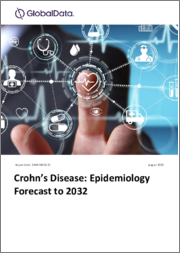크론병(CD, Crohn's Disease)은 염증성 장질환(IBD)의 일종으로, 소화관의 만성 염증이 특징으로 복통, 심한 설사, 피로, 체중감소, 영양불량을 일으킵니다. 가장 일반적으로 소장의 말단이 대장의 시작과 결합하는 부분에서 발생합니다. 크론병에 의한 염증은 사람에 의해 소화관의 다른 부위에 걸릴 수 있으며 가장 흔한 것은 소장입니다. 이 염증은 종종 장의 심층으로 퍼집니다.
남성과 여성 모두 병에 걸릴 수 있으며 연령에 관계없이 발병하지만 CD는 여성과 청소년에서 더 많이 볼 수 있습니다. 식사와 스트레스는 CD를 악화시킬 수 있지만 질병의 원인은 아닙니다. 최근 연구는 유전, 유전적 요인, 환경 요인이 CD의 발병에 관여하고 있음을 시사합니다. 크론병은 통증과 쇠약을 동반하며 때로는 생명을 위협하는 합병증을 일으킬 수 있습니다. 크론병의 염증은 장에 심각한 흉터를 남기고 장의 일부를 좁힙니다. 크론병의 치료법은 확립되어 있지 않지만, 치료에 의해 증상이나 징후를 대폭 경감시켜, 장기적인 관해나 염증의 치유를 초래하는 것도 가능합니다. 치료를 통해 많은 크론병 환자가 좋은 기능을 발휘할 수 있습니다.
주요 8개국 시장에서 크론병으로 진단받은 환자 수는 2022년 118,885명에서 2032년 122,175명으로 증가했으며 연간 성장률(AGR)은 0.28%가 될 것으로 예상됩니다. 2032년에는 미국이 68,815명과 주요 8개국 시장 중 가장 많으며 프랑스는 4,560명으로 가장 적을 것으로 예상됩니다. GlobalData의 역학자들은 CD로 진단되는 우발증 환자 수의 증가는 각 시장의 인구 역학 변화로 인한 것으로 나타났습니다.
주요 8개국 시장에서 CD로 진단된 유병자 수는 2022년 162만 6,752명에서 2032년 169만 5,580명로 증가할 것으로 예측되며, AGR은 0.42%입니다. 2032년에는 미국이 75만 5,802명과 주요 8개국 시장에서 가장 많았고, 일본은 4만 4,732명으로 가장 적은 것으로 보입니다.
주요 8개국 시장(미국, 프랑스, 독일, 이탈리아, 스페인, 영국, 일본, 캐나다)에서 크론병의 위험 요인/동반 질환/세계 및 과거의 역학 동향/크론병 진단을 받은 상태 발병 사례와 진단된 유병률에 관한 10년간의 역학 예측 등을 정리하여 전해드립니다.
목차
목차
제1장 크론병 : 주요 요약
제2장 역학
- 질병의 배경
- 위험 요인와 동반 질환
- 세계적 및 역사적 동향
- 주요 8개국 시장 예측 조사 방법
- 크론병의 역학 예측(2022-2032년)
- 크론병 진단을 받은 건수
- 크론병 진단을 받은 발병 사례, 연령별
- 크론병 진단을 받은 발병 사례, 성별
- 크론병 진단을 받은 환자 수
- 크론병 진단을 받은 환자 수, 연령별
- 크론병 진단을 받은 환자 수, 성별
- 크론병 진단을 받은 환자 수, 중증도별
- 누공형성 크론병 진단을 받은 환자 수, 중증도별
- 완치된 크론병의 환자 수, 중증도별
- 토론
- 역학 예측의 인사이트
- COVID-19의 영향
- 분석의 한계
- 분석의 강점
제3장 부록
LYJ 23.09.04Abstract
Crohn's disease (CD) is a type of inflammatory bowel disease (IBD) characterized by chronic inflammation of the gastrointestinal tract, which can lead to abdominal pain, severe diarrhea, fatigue, weight loss, and malnutrition. It most commonly affects the end of the small intestine (the ileum) where it joins the beginning of the colon. Inflammation caused by Crohn's disease can involve different areas of the digestive tract in different people, most commonly the small intestine. This inflammation often spreads into the deeper layers of the bowel (Crohn's and Colitis Foundation of America, 2014; Mayo Clinic, 2022).
Men and women can both be affected, and the disease can occur at any age, but CD is more prevalent among women and in the young age population. Diet and stress may aggravate CD, but do not cause the disease. Recent research suggests hereditary, genetic, and environmental factors contribute to the development of CD (National Health Service, 2021a). Crohn's disease can be both painful and debilitating, and sometimes may lead to life-threatening complications (Mayo Clinic, 2022). Inflammation in CD can result in severe scarring and narrowing of parts of the bowel. There's no known cure for Crohn's disease, but therapies can greatly reduce its signs and symptoms and even bring about long-term remission and healing of inflammation. With treatment, many people with Crohn's disease can function well (National Health Service, 2021a; Mayo Clinic, 2022).
In the 8MM, the diagnosed incident cases of CD are expected to increase from 118,885 cases in 2022 to 122,175 cases in 2032, at an annual growth rate (AGR) of 0.28%. In 2032, the US will have the highest number of diagnosed incident cases of CD in the 8MM, with 68,815 cases, and France will have the fewest diagnosed incident cases of CD with 4,560 cases. GlobalData epidemiologists attribute the increase in the diagnosed incident cases of CD to changes in population dynamics in each market.
In the 8MM, the diagnosed prevalent cases of CD are expected to increase from 1,626,752 cases in 2022 to 1,695,580 cases in 2032, at an AGR of 0.42%. In 2032, the US will have the highest number of diagnosed prevalent cases of CD in the 8MM, with 755,802 cases, and Japan will have the fewest diagnosed prevalent cases of CD with 44,732 cases. GlobalData epidemiologists attribute the increase in the diagnosed prevalent cases of CD to changes in population dynamics in each market.
Scope
This report provides an overview of the risk factors, comorbidities, and the global and historical epidemiological trends for CD in the eight major markets (8MM: US, France, Germany, Italy, Spain, UK, Japan, and Canada). The report includes a 10-year epidemiology forecast for the diagnosed incident cases and diagnosed prevalent cases of CD. The diagnosed incident cases and diagnosed prevalent cases of CD are segmented by age (for all ages in 10-year age groups for ages 0-9 years up to 80 years and older), and sex. The report also provides the diagnosed prevalent cases of fistulizing CD as well as diagnosed prevalent cases of CD in remission in each of the severity segments. This epidemiology forecast for CD is supported by historical data obtained from peer-reviewed articles and population-based studies. The forecast methodology was kept consistent across the 8MM to allow for a meaningful comparison of the forecast incident and prevalent cases of CD across these markets.
Reasons to Buy
The CD epidemiology series will allow you to -
- Develop business strategies by understanding the trends shaping and driving the global CD market.
- Quantify patient populations in the global CD market to improve product design, pricing, and launch plans.
- Organize sales and marketing efforts by identifying the age groups that present the best opportunities for CD therapeutics in each of the markets covered.
Table of Contents
Table of Contents
1 Crohn's Disease: Executive Summary
- 1.1 Catalyst
- 1.2 Related reports
- 1.3 Upcoming reports
2 Epidemiology
- 2.1 Disease background
- 2.2 Risk factors and comorbidities
- 2.3 Global and historical trends
- 2.4 8MM forecast methodology
- 2.4.1 Sources
- 2.4.2 Forecast assumptions and methods
- 2.4.3 Forecast assumptions and methods: diagnosed incident cases of CD
- 2.4.4 Forecast assumptions and methods: diagnosed prevalent cases of CD
- 2.4.5 Forecast assumptions and methods: diagnosed prevalent cases of CD by severity, diagnosed prevalent cases of fistulizing CD by severity, and diagnosed prevalent cases of CD in remission by severity
- 2.5 Epidemiological forecast for Crohn's disease (2022-32)
- 2.5.1 Diagnosed incident cases of CD
- 2.5.2 Age-specific diagnosed incident cases of CD
- 2.5.3 Sex-specific diagnosed incident cases of CD
- 2.5.4 Diagnosed prevalent cases of CD
- 2.5.5 Age-specific diagnosed prevalent cases of CD
- 2.5.6 Sex-specific diagnosed prevalent cases of CD
- 2.5.7 Diagnosed prevalent cases of CD by severity
- 2.5.8 Diagnosed prevalent cases of fistulizing CD by severity
- 2.5.9 Diagnosed prevalent cases of CD in remission by severity
- 2.6 Discussion
- 2.6.1 Epidemiological forecast insight
- 2.6.2 COVID-19 impact
- 2.6.3 Limitations of the analysis
- 2.6.4 Strengths of the analysis
3 Appendix
- 3.1 Bibliography
- 3.2 Primary Research - Prescriber Survey
- 3.3 About the Authors
- 3.3.1 Epidemiologist
- 3.3.2 Reviewers
- 3.3.3 Vice President of Disease Analysis and Intelligence
- 3.3.4 Global Head and EVP of Healthcare Operations and Strategy
- Contact Us


















